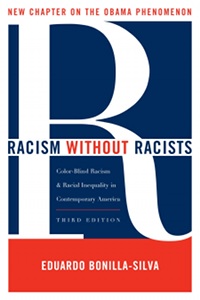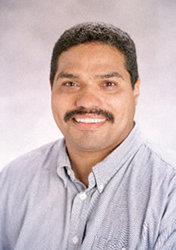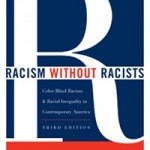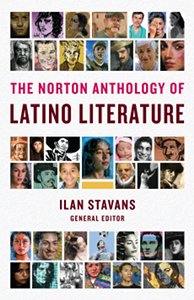Posted by Elena del Valle on September 10, 2010

Racism without Racists book cover
Photos: Rowman & Littlefield Publishers, Inc.
In the first edition of Racism without Racists Color-Blind Racism and Racial Inequality in Contemporary America (Rowman and Littlefield) Eduardo Bonilla-Silva, Ph.D., professor of sociology at Duke University, shared his concerns about what he describes as “the new racial ideology,” how he believes the new system has replaced the old system and is as effective. In the second edition of the book, he expanded on the issue by addressing his views of a growing fissure of race stratification similar to the one he believes exists in Latin America’s pluralistic societies.
In the third edition of the book, published earlier this year, he added a section about what he calls the Obama Phenomenon. He also discusses conservative minorities that make their living (or their fortune) defending what some consider views unfavorable to the minority group or groups they should identify with because of their race and cultural background.
The 301-page softcover book is divided into 10 chapters: The Strange Enigma of Race in Contemporary America, The Central Frames of Color-Blind Racism, The Style of Color Blindness: How to Talk Nasty About Minorities without Sounding Racist, “I Didn’t Get That Job Because of a Black Man”: Color Blind Racism’s Racial Stories, Peeking Inside the (White) House of Color Blindness: The Significance of Whites’ Segregation, Are All Whites Refined Archie Bunkers? An Examination of White Racial Progressives, Are Blacks Color Blind, Too?, E Pluribus Unum or The Same Old Perfume in a New Bottle? On the Future of Racial Stratification in the United States, Will Racism Disappear in Obamerica? The Sweet (but Deadly) Enchantment of Color Blindness in Black Face, and Conclusion: “The (Color-Blind) Emperor Has No Clothes:” Exposing the Whitness of Color Blindness.
One chapter from the previous edition, Chapter 10, the appendix with the interview schedule for the 1998 DAS and the postscript for the text were removed. They are available on the publisher’s website, according to the author’s Preface.

Author Eduardo Bonilla-Silva
Bonilla-Silva believes President Barack Obama and his regime represent the “new racism” and that his policies represent the color-blind ideology he outlines in his book. In addition, Bonilla-Silva outlines his belief in the book in the idea that the President’s policies and the way others are framing his government may further precipitate what the author sees as the country’s Latin America like racial stratification.
In addition to this book Bonilla-Silva is the author or co-author of White Supremacy and Racism in the Post Civil Rights Era, White Out, and White Logic White Methods: Racism and Methodology. His next book is titled The Invisible Weight of Whiteness: The Racial Grammar of Everyday Life in the U.S.A.

Click here to buy Racism without Racists
Comments:
Filed Under: Books
Posted by Elena del Valle on September 8, 2010
Part two of a series
By Hilda Luisa Díaz-Perera

Hilda Luisa Díaz-Perera
Where did the guayabera come from and is there a history behind it? Most of the time, where it concerns popular history, those who have made a difference in the lives of millions of people were never aware of it, and therefore the facts of whatever they contributed to mankind is lost in the jumble of reality, fiction and, in the case of the guayabera, in the fantasy of romance.
According to research conducted by Cuban journalist Pedro Carballo Bernal, several Andalusian and later Canary Island families who settled in Cuba around the Yayabo River, in Sancti Spiritus, began making shirts that would eventually become the precursors or prototypes of today’s guayaberas. More precisely, as the story goes, the first guayabera was made in 1709, by Encarnación Núñez García, an Andalusian wife from the town of Granada, hoping to please her husband, José Pérez Rodríguez, a potter by trade, who requested that she make him comfortable, loose shirts from a bolt of fine Belgian linen they had received from Spain.
Click here to read parts one and two of La Guayabera, a multi-part series
Posted by Elena del Valle on September 3, 2010

The Norton Anthology of Latino Literature
Photo: Sam Masinter
A compendium of the Latino literary tradition, The Norton Anthology of Latino Literature (W. W. Norton; $59.95) is due to be published in hardcover September 13, 2010. The heavy hardcover book has 2,489 pages plus 177 appendix pages. The book features the work of 201 Latino writers from Chicano, Cuban-American, Puerto Rican, and Dominican-American traditions, and writing from other Spanish-speaking countries. Works from writers of Brazil, Portugal and the Philippines were excluded.
Ilan Stavans, a cultural critic and Lewis Sebring Professor of Latin American and Latino Culture at Amherst College, was the general editor of the title which traces five centuries of writing, from letters to the Spanish crown by sixteenth-century conquistadors to the expressions of twenty-first-century cartoonists and artists of reggaeton. It took 13 years to gather the information and make the book a reality.
The book is divided into six chronological sections: Colonization, Annexation, Acculturation, Upheaval, Into the Mainstream, and Popular Tradition and includes samples of the work of José Martí, William Carlos Williams, Julia Alvarez, Oscar Hijuelos, Cristina García, Piri Thomas, Esmeralda Santiago, and Junot Díaz. Three appendices, Chronology-Literature and History; Treaties, Acts and Propositions; and Influential Essays by Latin American Writers precede a Selected Biography section.
The selection was based on four thematic emphases: identifying Latinos for purposes of the book as those writers from Spanish speaking countries living in the United States regardless of the length of time they resided in the country or their race while taking into account that the events and circumstances of more than one nation may have influenced some of the authors.

Ilan Stavans, general editor, The Norton Anthology of Latino Literature
Mexico City born Stavans, a writer and public television host, authored Growing Up Latino and Spanglish. He lives in Amherst, Massachusetts. Other editors listed at the beginning of the book are: Edna Acosta-Belén, a Distinguished Professor of Latin American, Caribbean, and U.S. Latino Studies and Women’s Studies, University of Albany, State University of New York; Harold Augenbraum, executive director, National Book Foundation; María Herrera-Sobek, associate vice chancellor for Diversity, Equity and Academic Policy and professor in the Department of Chicana and Chino Studies, University of California, Santa Barbara; Rolando Hinojosa, Ellen Clayton Garwood Professor of Creative Writing, University of Texas at Austin; and Gustavo Pérez Firmat, David Feinson Professor of Humanities, Columbia University.

Click here to buy The Norton Anthology of Latino Literature
Comments:
Filed Under: Books
Posted by Elena del Valle on September 1, 2010
Part one of a series
By Hilda Luisa Díaz-Perera

Hilda Luisa Díaz-Perera
Salsa is Cuban. The bolero is Cuban. So is a cigar worthy of the name, the Cuba Libre, the mojito and also, believe it or not, the guayabera. I can’t remember life without it. I bought my Chinese-Cuban-American grandson his first guayabera, the tiniest thing, when he was barely a few days old: “Little man” I said, “Welcome to our culture!”
The guayabera is solidly etched in the psyche of a Cuban woman of my generation. I think most of us are emotionally bound to it through memories we hold very dear of fathers, grandfathers, and older family patriarchs wearing them. I can remember the day my then young and very conservative grandfather, finally gave in to my grandmother’s pleas to wear long-sleeved guayaberas instead of sitting through his meals fully suited, in the hot, Cuban weather.
Click here to read the entire article La Guayabera, part of a multi-part series.
Posted by Elena del Valle on August 30, 2010

BlackBerry cell phone
Photos: AT&T, Verizon
An increasing percentage of people in the United States is taking advantage of cell phone and wireless laptop access to the internet. According to the results of a Pew Research Center’s Internet and American Life Project survey released in July 2010, 59 percent of adult respondents said they access the internet with a wireless system through a cell phone or laptop computer. In 2009, 51 percent of survey respondents said they accessed the internet with a wireless system through a cell phone or laptop computer.
In the last year, 47 percent of adults said they went online with a laptop WiFi connection or a mobile broadband card. This represents an increase compared to 39 percent who said they did that in April 2009; 40 percent said they access the internet, email or instant messaging on a mobile phone compared with 32 percent who said they did that in 2009.

Verizon and ZTE USA AD3700 USB modem
People are also using non voice phone applications more than in the past. More people are taking pictures, 76 percent compared to 66 in April 2009; 72 percent send or receive text messages compared to 65 percent in 2009; 38 percent access the internet compared to 25 percent in 2009; 34 percent play games compared to 27 percent in 2009; 34 percent send or receive email compared to 25 percent in 2009; 34 percent said they record a video compared to 19 percent in 2009; 33 percent said they play music compared to 21 percent in 2009; and 30 percent send or receive instant messages compared to 20 percent in 2009.
Contrary to a recent Pew Hispanic Center report that indicated Latinos lag behind in their use of technology compared to the general population (see Latinos lag behind in use of technology compared to non Latinos), in this survey researchers concluded that African-Americans and English-speaking Latinos, remain among the most active users of these technologies. The Pew Hispanic Center report included Spanish dominant Latinos while this one only mentioned English speaking Latinos. More African-Americans and Latinos, 87 percent, own cell phones than whites 80, according to the survey responses.
They also use more of their phone’s features compared with white mobile phone owners. This year more African-Americans (64 percent) said they access the internet from a laptop or mobile phone, compared to 57 percent who said they did in 2009.
“The Hispanic consumer market is one of the fastest growing in the U.S. and is very attractive to wireless providers, not just in terms of growing population but also in terms of usage. Hispanics over-index in almost every category: They use more minutes, they make more long-distance calls, they text more, and they download more ringtones” said Kelly Starling, spokesperson, AT&T.
The report, Mobile Access 2010, released July 7, 2010 is based on the findings of a daily tracking survey on Americans’ use of the internet. The data is from telephone interviews, in English, of 2,252 adults 18 years old and older conducted by Princeton Survey Research Associates International between April 29 and May 30, 2010.
Posted by Elena del Valle on August 27, 2010
By Marga Fournier-Padró

A Death in Dallas book cover
Photos: Ascot Media Group, Inc.
In A Death in Dallas (Publish America, $24.95), a 239-page novel, Ernest E. Hunt addresses the subject of human slavery and drug trafficking, an issue that has existed almost since the beginning of time. Greediness, hunger for power and the weaknesses of many who fall prey to such crimes, leads to exploitation and human slavery. Much has been written and showcased in film about this subject of sex, rape, revenge, crime, drugs and human trafficking.
In A Death in Dallas a young Mexican schoolgirl is kidnapped, along with other students, from a border town in Mexico and smuggled into the United States by degenerates from both sides of the border. Smugglers from other countries down south use the same Mexican routes to take advantage of existing routes and corruption, deriving huge profits from exchanging girls and women for sex, especially the very young. There is also the added attraction and very profitable business of narcotic drugs.
The murder of a man on a street in Dallas left a mystery, a why. Someone phoned the police department to report a crime. When the police arrived they found a body but no witness. Was the deceased placed there to attract someone to shoot at? Did the sniper mean to shoot a policeman who came to investigate the death or simply to scare someone? Did it have anything to do with the kidnapping of the young Mexican girl? The mystery led authorities to discover a smuggling ring of humans and drugs.
The author brings together characters whose life mishaps produce enough adrenaline to cause a reaction between characters and allows them to understand each other’s pain. For some, their own internal crucifixion pushes them in favor of vengeance. For others, justice, duty or anger brings them together to fight and find ways to stop so much hurt and abuse.
The Iraq War leaves a soldier’s face and soul scarred. Mexplotations leaves a group of young girls terrified and scarred because of horrific abuses. The greed for power among members of a well known family who have lost their values and ethics makes some of them indulge in the worst kind of vices for the sake of money to buy their way to congress and for devious fun.

Author Ernest E. Hunt
An Iraq war hero’s somber thoughts make him perform a sniper act that eventually changes his life. The hero meets the heroine in a brothel and together they part in search of justice. The innocence and intelligence of the very young abused heroine draws more characters and drama into the story.
The members of a religious congregation, detectives, police from both sides of the border and even an employee distraught by the meanness of her employer join forces to uncover the source of the sex-drug ring and to entrap those involved, lifting a veil of scandal and corruption.
Although the author explains the horror of human degradation lived by Juanita Delgato, he only touches the tip of a slavery iceberg. In real life, outside of inner vice circles and advocates who fight for these victims, people don’t have the slightest idea of the horror stories lived by children involved in this human racket, be it in Nuevo Laredo, Juárez, Cancún in Mexico or in any city in the United States; activities that should be stopped and penalized everywhere and by all nations.
Fortunately, clean and pure love sprouts among some of the characters to overpower their own sad family love stories. The author’s search for factual sources enhances and adds substance to the book. Some could call it a thriller; however, it is a description of a very sad reality being lived every minute somewhere in the world. Nevertheless, the subtle way, language and sources of justice used by Hunt to vindicate much sorrow in some of the characters involved makes this story worth reading. His descriptive power made me feel like I was traveling along with each character, admiring or disliking the scenery and the story evolution.
According to his biography, Hunt was ordained in the Episcopal Church at Stanford University and was rector of the Church of the Epiphany in Manhattan for 16 years. He spent four years in Saint Matthews and 11 years in Paris, France.
There is no doubt that the author´s background influenced this fictional story, as he describes it, with the credibility of human violations happening every second all over the world. He was able to capture the essence of the problem, ending the story in a language that does not offend, one that can be read by students to open their eyes and make them aware of predators and people with few scruples.

Click here to buy A Death in Dallas
Comments:
Filed Under: Books
Posted by Elena del Valle on August 26, 2010
Information provided by our Event Partner

24th Annual NAMIC Conference – “3D: Diversity, Digital, Demographics”
September 14 -15, 2010
Hilton New York
Presented as part of Diversity Week
Don’t miss the communications industry’s leading diversity symposium! Presented by the National Association for Multi-ethnicity in Communications (NAMIC), the 24th Annual NAMIC Conference “3D: Diversity, Digital, Demographics” will present diversity and inclusion through the 3D, stereoscopic lens of the communications industry’s business operations, expanding distribution platforms, and content development for a culturally complex and globally connected viewership.
We invite professionals at every organizational level to attend this premier educational event where they will interact with leaders at the forefront of innovation; discover new ways to leverage diverse perspectives within their own companies; and receive valuable insights into business and career strategies.
The two-day agenda will focus on Digital Media, Diversity & Inclusion, Leadership Development and Multi-ethnic Content & Programming, as well as “hot topic” sessions such as Hispanic America 2010 presented by The Nielsen Company and the Excellence in Multi-cultural Marketing Awards (EMMA). Special events include the L. Patrick Mellon Mentorship Program Luncheon, Mickey Leland Humanitarian Achievement Award Luncheon, Breakfast Honoring the CableFAX “Most Influential Minorities in Cable,” Diversity in Communications Career Expo and strategic networking opportunities.
Register online at www.namic.com. For more information and sponsorship opportunities, contact NAMIC at 212-594-5985. Group registration discounts are available. Register early and save.
Posted by Elena del Valle on August 25, 2010
By Adrienne E. Katz Katz

Adrienne E. Katz Katz
Mankind has walked on Earth for thousands of years, but women have been allowed to vote for only ninety years! It took 131 years after the U.S. Constitution was adopted before American men grudgingly granted women the right to vote.
Every woman today who has in her own name a job, a bank account, a credit card, a lease, a car, a mortgage, a diploma or a pension has these because she is standing on the shoulders of millions of women who fought for those privileges.
The United States is celebrating Women’s Equality Day on August 26, commemorating the passage of the 19th Amendment to the U.S. Constitution. This amendment gave women the right to vote on this date in 1920.
Click here to read the entire article Look how far we’ve come and how far we still have to go
Posted by Elena del Valle on August 24, 2010
Information provided by our Event Partner

The 8th Annual Hispanic Television Summit
Wednesday, September 29, 2010, Hilton New York Hotel
Special Offer for HispanicMPR.com subscribers
$50 off regular price of $399 until September 1st ($349) &
$100 off regular price of $499 after September 1st ($399)
The 8th Annual Hispanic Television Summit will be held Wednesday, September 29, 2010 at the Hilton New York Hotel. It is presented by Broadcasting & Cable and Multichannel News. Oscar De La Hoya will be honored for A Lifetime of Achievement in Hispanic Television. Confirmed keynote speakers are Ramón Escobar, EVP Telemundo; Diane Jones Lowrey, Director Diversity Marketing & Operations, Levi Strauss & Company; Alita Vegas, Director Multicultural Marketing, P&G. The Summit is the signature conference for executives involved in the business of television and digital video targeted to the US Hispanic and Latin American viewing audience and attended by over 400 key industry executives.
To register, please visit www.broadcastingcable.com/hispanic2010, www.multichannel.com/hispanic2010 or call Sandy Friedman at 646-746-6740.
Posted by Elena del Valle on August 23, 2010

Romano Richetta, senior vice president, Participant Services, TIAA-CREF
Photo: TIAA-CREF
A podcast interview with Romano Richetta, senior vice president, Participant Services, Teachers Insurance and Annuity Association College Retirement Equities Fund (TIAA-CREF) is available in the Podcast Section of Hispanic Marketing & Public Relations, HispanicMPR.com. During the podcast, Romano discusses his company’s Spanish language initiatives to provide United States Latinos access to a secure retirement with Elena del Valle, host of the HispanicMPR.com podcast.
Romano has served as senior vice president of Participant Services at TIAA-CREF since July 2006. He oversees TIAA-CREF’s Call Center and Field Consulting Group with more than 1,400 employees. From November 2001 to May 2006, Romano served as senior vice president at JPMorgan Chase & Co. where he managed the Telephone Channel in the retail bank.
Prior to joining that company he was a senior manager at Deloitte & Touche LLP serving as an operations and strategy consultant. Romano, who holds a Masters degree from Massachusetts Institute of Technology and an MBA from the University of Texas at Austin, is a registered principal and registered representative.
To listen to the interview, scroll down until you see “Podcast” on the right hand side, then select “HMPR Romano Richetta” click on the play button below or download the MP3 file to your iPod or MP3 player to listen on the go, in your car or at home. To download it, click on the arrow of the recording you wish to copy and save it to disk. The podcast will remain listed in the August 2010 section of the podcast archive.

























